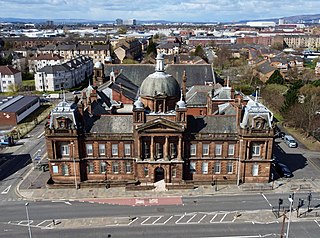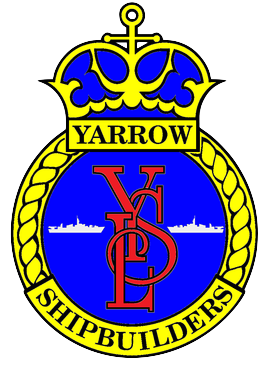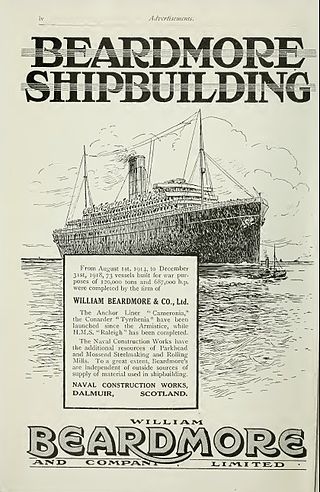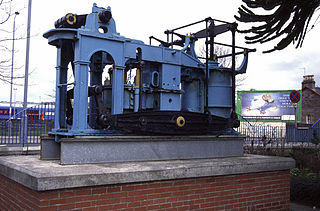
Harland & Wolff is a British shipbuilding and fabrication company headquartered in London with sites in Belfast, Arnish, Appledore and Methil. It specialises in ship repair, shipbuilding and offshore construction. Harland & Wolff is famous for having built the majority of the ocean liners for the White Star Line, including Olympic-class trio – RMS Olympic, RMS Titanic and HMHS Britannic. Outside of White Star Line, other ships that have been built include the Royal Navy's HMS Belfast; Royal Mail Line's Andes; Shaw, Savill & Albion's Southern Cross; Union-Castle's RMS Pendennis Castle; P&O's Canberra; and Hamburg-America's SS Amerika of 1905. Harland and Wolff's official history, Shipbuilders to the World, was published in 1986.

Govan is a district, parish, and former burgh now part of southwest Glasgow, Scotland. It is situated 2+1⁄2 miles west of Glasgow city centre, on the south bank of the River Clyde, opposite the mouth of the River Kelvin and the district of Partick. Historically it was part of the County of Lanark.

Swan Hunter, formerly known as Swan Hunter & Wigham Richardson, is a shipbuilding design, engineering, and management company, based in Wallsend, Tyne and Wear, England.

The Thames Ironworks and Shipbuilding Company, Limited was a shipyard and iron works straddling the mouth of Bow Creek at its confluence with the River Thames, at Leamouth Wharf on the west side and at Canning Town on the east side. Its main activity was shipbuilding, but it also diversified into civil engineering, marine engines, cranes, electrical engineering and motor cars.

Yarrow Shipbuilders Limited (YSL), often styled as simply Yarrows, was a major shipbuilding firm based in the Scotstoun district of Glasgow on the River Clyde. It is now part of BAE Systems Surface Ships, owned by BAE Systems, which has also operated the nearby Govan shipyard since 1999.

The Fairfield Shipbuilding and Engineering Company, Limited, was a Scottish shipbuilding company in the Govan area on the Clyde in Glasgow. Fairfields, as it is often known, was a major warship builder, turning out many vessels for the Royal Navy and other navies through the First World War and the Second World War. It also built many transatlantic liners, including record-breaking ships for the Cunard Line and Canadian Pacific, such as the Blue Riband-winning sisters RMS Campania and RMS Lucania. At the other end of the scale, Fairfields built fast cross-channel mail steamers and ferries for locations around the world. These included ships for the Bosporus crossing in Istanbul and some of the early ships used by Thomas Cook for developing tourism on the River Nile.

John Brown and Company of Clydebank was a Scottish marine engineering and shipbuilding firm. It built many notable and world-famous ships including RMS Lusitania, RMS Aquitania, HMS Hood, HMS Repulse, RMS Queen Mary, RMS Queen Elizabeth and Queen Elizabeth 2.

William Beardmore and Company was a British engineering and shipbuilding conglomerate based in Glasgow and the surrounding Clydeside area. It was active from 1886 to the mid-1930s and at its peak employed about 40,000 people. It was founded and owned by William Beardmore, later Lord Invernairn, after whom the Beardmore Glacier was named.

Scotts Shipbuilding and Engineering Company Limited, often referred to simply as Scotts, was a Scottish shipbuilding company based in Greenock on the River Clyde. In its time in Greenock, Scotts built over 1,250 ships.

Palmers Shipbuilding and Iron Company Limited, often referred to simply as "Palmers", was a British shipbuilding company. The company was based in Jarrow, County Durham, in north-eastern England, and had operations in Hebburn and Willington Quay on the River Tyne.
R. & W. Hawthorn, Leslie and Company, Limited, usually referred to as Hawthorn Leslie, was a shipbuilder and locomotive manufacturer. The company was founded on Tyneside in 1886 and ceased building ships in 1982.

A & J Inglis, Ltd, was a shipbuilding firm founded by Anthony Inglis and his brother John, engineers and shipbuilders in Glasgow, Scotland in 1862. The firm built over 500 ships in a period of just over 100 years. Their Pointhouse Shipyard was at the confluence of the rivers Clyde and Kelvin. They constructed a wide range of ships, including Clyde steamers, paddle steamers and small ocean liners. In wartime, they built small warships, and in the period after World War II, they built a number of whalers.

William Beardmore, 1st Baron Invernairn, DL, known as Sir William Beardmore, Bt, between 1914 and 1921, was a British industrialist, founding the eponymous William Beardmore and Company.

Robert Napier was a Scottish marine engineer known for his contributions to Clyde shipbuilding.

Charles Connell and Company was a Scottish shipbuilding company based in Scotstoun in Glasgow on the River Clyde.
James Robert Napier, FRS, Scottish engineer and scientific writer, was the inventor of Napier's diagram, a tool for nautical navigation.

SS Armadale Castle was a passenger steamship built in 1903 at Fairfield Shipbuilding and Engineering, Govan, Scotland, for the Union-Castle Mail Steamship Co Ltd, London, the first ship ordered for the newly formed company.

The Glenavon was a British iron cargo ship of the Glen Line that was wrecked off the coast of China in 1898. Four people, but not the master, lost their lives in the wreck. The master had his licence suspended for one year.

Messrs Robert Napier and Sons was a famous firm of Clyde shipbuilders and marine engineers at Govan, Glasgow founded by Robert Napier in 1826. It was moved to Govan for more space in 1841. His sons James and John were taken into partnership in 1853.
















